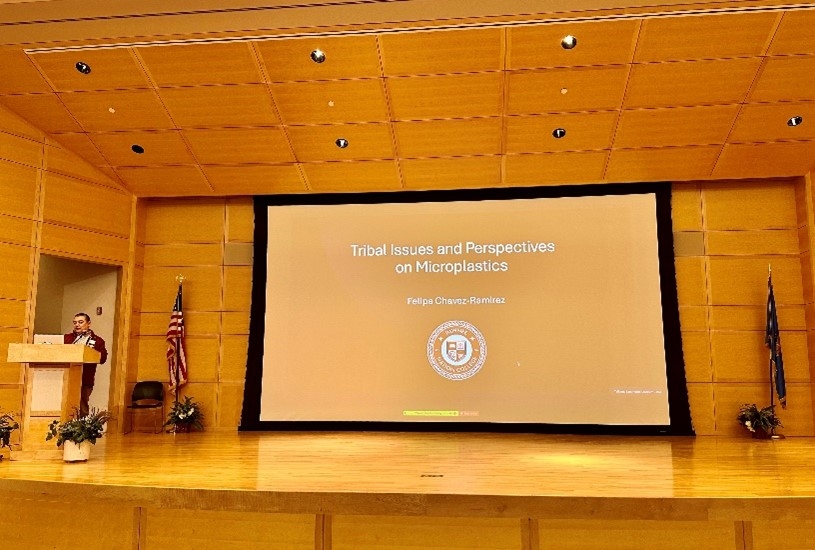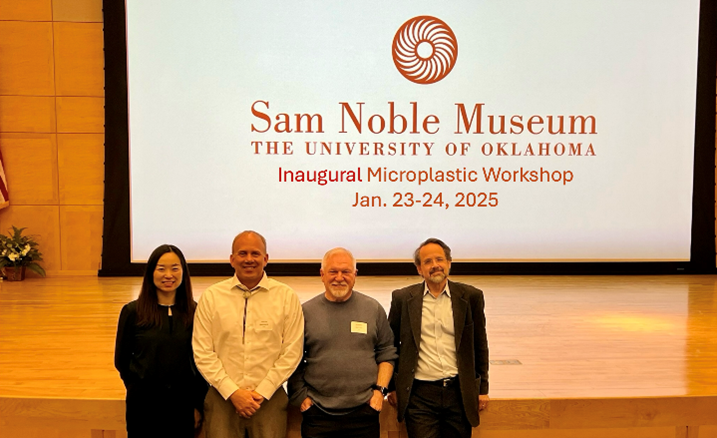
As part of their 2024 seed grant opportunity to catalyze new OU convergence research, the Institute for Resilient Environmental and Energy Systems (IREES), the Data Institute for Societal Challenges (DISC), and the Institute for Community and Societal Transformation (ICAST) awarded, Prof Tingting Gu, Ph.D., School of Biological Sciences, along with Co-PI Mark Nanny, Ph.D. School of Civil Engineering and Environmental Science, and Joseph Suflita, Ph. D., Emeritus Professor in the School of Biological Sciences, funding to explore the development of an OU-led Microplastic Pollution Research Center at OU.
The global concern over plastic contamination continues to grow, particularly regarding microplastic and nanoplastic (MNP) pollution in the environment and its potential impact on animal and human health. MNPs, defined as polymeric fragments smaller than 5000 microns, primarily result from the physical and chemical degradation of synthetic polymers used in all aspects of modern life. Over the past decade, these particles have been detected throughout the hydrosphere, atmosphere, and geosphere. Furthermore, MNPs have been found in nearly all animals tested, including humans, as they are now nearly ubiquitously ingested and inhaled in both natural and built environments across the globe. Beyond their physical presence and inherent dangers, MNPs can also adsorb organic chemicals, heavy metals, bacteria, and viruses, serving as transport vectors for additional contaminants. Due to the complex chemical and structure forms found in nature, the numerous ways they can affect human health, and the absence of standardized detection and identification methods, studying MNPs remains a significant challenge.
To address these evolving, complex, and interacting concerns, Professor Gu and the team convened a regional workshop at OU, Jan 24-25, 2025, where thought leaders and practitioners gathered to identify critical research needs and establish meaningful strategies for microplastic pollution management. This Microplastic Research Workshop, held at the Sam Noble Museum of Natural History, brought together a diverse group of stakeholders, including federal agencies (U.S. Geological Survey and the Environmental Protection Agency), state agencies (the Oklahoma Department of Environmental Quality), the City of Norman, OK, industry, the legal professional, public health managers, academic researchers and students (including OU, the OU Health Sciences Center, East Central University, and Oklahoma State University), and tribal nation representatives. The two-day event included presentations on research needs and challenges, known exposure impacts, and challenges in communicating the threats to the public. Additionally, break-out sessions were organized to delve into opportunities for specific groups to address these challenges and develop actionable research questions and strategic plans to support the creation of the OU Microplastic Research Center. In particular, one break-out session, organized through IREES and its director Tim Filley, focused on Tribal Nation perspectives and programs and included representation from offices managing natural resources and environmental protection from the Comanche Nation, Kiowa Nation, Muscogee Nation, Pawnee Nation, and the Wichita and Affiliated Tribes.
“Events such as this helps to create the working space and relationships that can make for long-lived and meaningful partnerships to address barriers to controlling microplastic pollution. IREES is honored to participate in this step forward.” Pawnee Nation College Chief Academic Officer and natural science coordinator Felipe Chavez-Ramirez provided his perspective on the need for better education among tribal communities in his presentation “Tribal issues and perspectives on Microplastics.”
Originally expected to attract around 30 participants, the workshop received an overwhelming response, drawing over 80 attendees, including both graduate and undergraduate students. By fostering partnerships and generating innovative strategies, this workshop represented a significant stride toward understanding and controlling microplastic pollution, aligning OU's research initiatives with global efforts to protect ecosystems and human health.
Written By: Mikayla Foreman, Dr. Tim Filley, Dr. Tingting Gu, Dr. Joseph Suflita, and Dr. Mark Nanny
